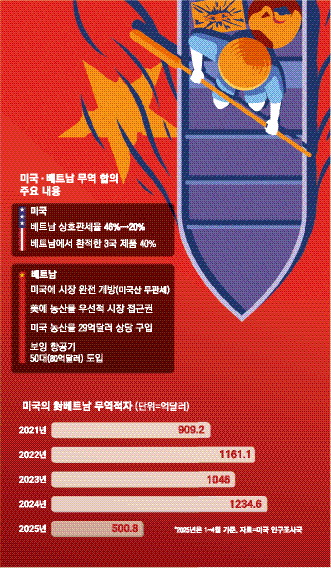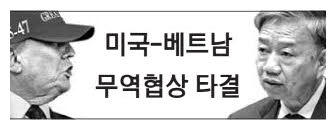 사진 확대
사진 확대
U.S. President Donald Trump gave Vietnam, Asia’s No. 1 trade negotiator, a gift of a “26 percentage point reduction” in mutual tariffs. Vietnam has set the stage for recognizing its status as a ‘market economy’ by deciding to set tariffs on US imports at ‘0%.
Vietnam’s Communist Party secretary, Dorum, who reached a trade deal with the Trump administration, said in a phone call with President Trump that the U.S. quickly recognized Vietnam as a market economy and asked him to lift export restrictions on certain high-tech products, Vietnamese media VN Express reported on the 2nd (local time). Secretary-General Rum officially invited President Trump to visit Vietnam, and President Trump also thanked him.
This seems to have sent a message to trade negotiators that there will be “benefits” of tariff cuts if they accept U.S. requests. On the other hand, as seen in the case of Japan, which is struggling, even allies are pressing for an early settlement, warning that they will impose higher “penalties” than the original mutual tariffs.
The Vietnamese government’s efforts, which began during the second Trump administration, have paid off. In November last year, shortly after President Trump won the presidential election, Vietnamese Prime Minister Palm Min-chin announced to the U.S. ambassador to Vietnam that he would purchase U.S. products such as aircraft, liquefied natural gas, and agricultural products. Efforts were also made to win the favor of President Trump, including the introduction of the U.S. satellite service Starlink and the construction of the Trump golf course.
Vietnam gave President Trump a big gift to agree on mutual tariffs on Vietnamese imports at 20%, far lower than the 46% initially announced. Vietnam has decided to remove all tariffs on U.S. goods. “Vietnam will open its market to the United States,” President Trump said on Truth Social, a social network service (SNS), adding, “It means that we will be able to sell products to Vietnam without tariffs.”
In addition, President Trump expected U.S.-made sports utility vehicles or large engine vehicles to be exported to Vietnam. The draft joint statement also included Vietnam’s decision to introduce 50 U.S. Boeing aircraft for $8 billion (about 11 trillion won) and confirming a memorandum of understanding (MOU) to purchase $2.9 billion worth of U.S. agricultural products, according to Politico.
 사진 확대
사진 확대
The market response was also positive. According to Reuters, Nike shares, which are highly dependent on Vietnam, surged 4%. Levi’s, known for its underarmor and Levi’s jeans, also rose nearly 2%, respectively.
“Investors may see the agreement as a sign that much of the threatening tariffs (on Vietnam and other countries) will be withdrawn,” Morningstar research analyst David Swartz said. The S&P 500 Index reached an all-time high on the same day. Vietnam, which accounts for 30% of the U.S. total exports, has lessened its burden by concluding tariff negotiations with the U.S.
However, establishing a relationship with China is a challenge. This is because President Trump clearly expressed his willingness to check China through the trade agreement signed with Vietnam. The U.S. decided to lower mutual tariffs on Vietnamese goods from 46% to 20%, but decided to impose a 40% tariff on transshipment products exported by third countries to the U.S. via Vietnam. In other words, China is aiming for the practice of “origin laundering” in which it moves from Vietnam and exports to the United States to avoid high tariffs.
Bloomberg reported on the same day that the Trump administration is pushing for trade negotiations with trading partners in the direction of isolating China from the global supply chain in a trade agreement with Vietnam. India, which is close to a trade agreement with the United States, is also negotiating with the United States on rules of origin, Bloomberg said. According to the South China Morning Post (SCMP), US government officials recently pressed Vietnamese officials to end their transshipment hub role.
According to the Financial Times (FT), China’s exports to Southeast Asia surged more than 20% year-on-year in April when President Trump announced mutual tariffs. Among them, exports to Vietnam increased by 22.96%. Peter Navarro, White House trade and manufacturing advisor, argued that one-third of Vietnam’s exports to the United States are Chinese products shipped through Vietnam.
The Chinese government is watching the U.S. government’s move. Tu Xinquan, a professor at the University of Foreign Economy and Trade and head of the World Trade Organization (WTO) in China, told Bloomberg, “China will definitely respond if a list explicitly targeting China is agreed and any country cooperates with the U.S. blockade of China.” China’s Ministry of Commerce maintains its position that “China strongly opposes reaching an agreement at the expense of China’s interests in exchange for tariff cuts.”
[Reporter Kim Deoksik]






